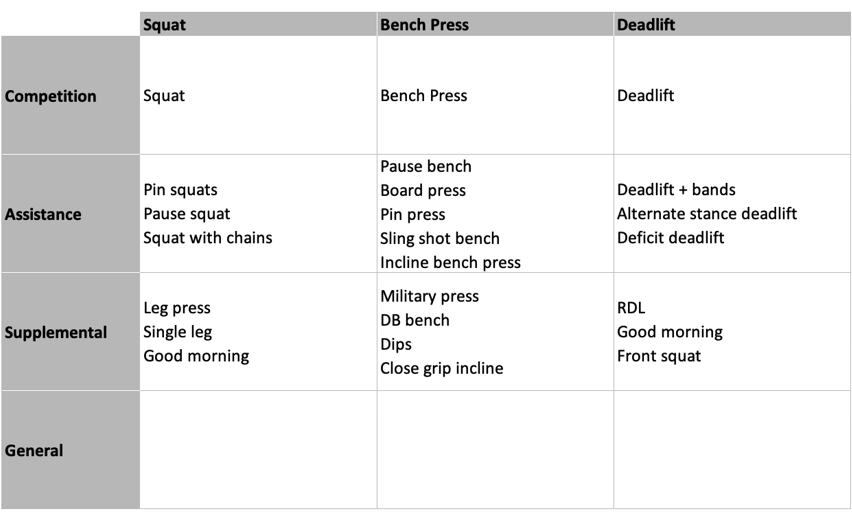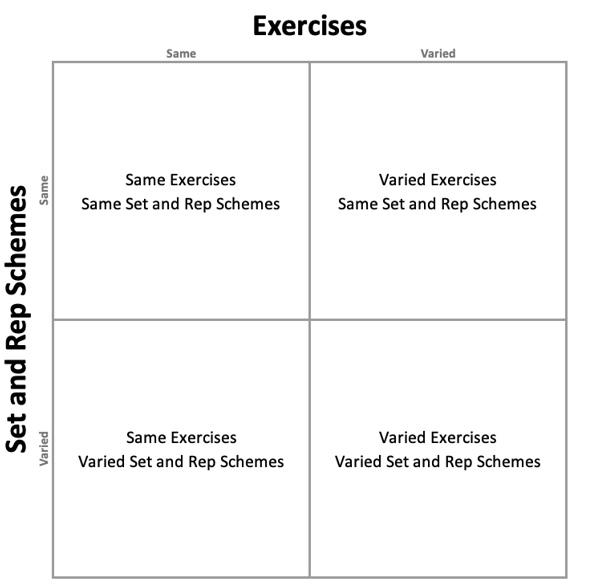Strength Training Manual: Exercises – Part 2
1. Introduction
2. Agile Periodization and Philosophy of Training
3. Exercises – Part 1 | Part 2
4. Prescription – Part 1 | Part 2 | Part 3
5. Planning – Part 1 | Part 2 | Part 3 | Part 4 | Part 5 | Part 6
I am very happy to announce that I am finishing the Strength Training Manual. I decided to publish chapters here on Complementary Training as blog posts for two reasons. First, I want to give members early access to the material. And second, this way I can gain feedback and correct it if needed before publishing it.
I look forward to hearing your thoughts.
Enjoy reading!
In the previous part,I’ve discussed the classification of the exercises into grinding and ballistic, covered common movement patterns, as well as introduced Time-Complexity quadrants. In this part, I will continue the discussion on exercise classification and introduce theslot concept, functional units,and very useful conversion tables and matrix. Conversion matrix is a very useful heuristic tool to figure out approximate 1RM of the assistance exercises (e.g., bench press 1RM is known, but what is 1RM for the military press, DB bench press, and so forth?).
Exercise Priority/Emphasis/Importance
Having an exercise pool for grinding and ballistic movements patterns is a necessary starting point, but not sufficient in deciding how to create a training program. The problem is how to choose the exercises? Which one is more important, which one should have higher priority?
To solve these problems, coaches usually utilize some type of exercises classification based on what they think is important. Importance can mean different things to different coaches and athletes of course, but the goal is to simplify decision-making when selecting what exercises to perform. The most common classification based on importance is to main exercises and assistance exercises. Figure 3.15 contains example categories from Jim Wendler (Wendler & Koss, 2013; Wendler, 2017) (or 5/3/1 fame), Joe Kenn (Kenn, 2003) and Mike Tuchscherer (Tuchscherer, 2008).

Figure 3.15. Exercise classification based on the importance
The importance is again a complex concept and can mean different things. Mike Tuchscherer utilizes specificity to competition lifts as a criterion, and his classification model is very similar to the Bondarchuk model (see Figure 3.3). Thus, importance in this strength specialist example refers to specificity and similarity with the main movements (squat, bench press, and deadlift). Figure 3.16 contains example exercises for each category for squat, bench press, and deadlift.

Figure 3.16. Mike Tuchscherer classification
Specific exercises can be selected based on the individual lifter qualities and needs, although a generic approach can exist (see Bayesian updating in Chapter 1).
When it comes to the strength generalist approach to exercise importance classification, usually we have some idea of the biggest bang for the bucks, amount of joints and muscle mass involved, or exercises that allow the highest loads. But again, there is no right or wrong answer here. An example of major grinding categories can be seen in Figure 3.17

Figure 3.17. Importance categories for major grinding movement patterns
But sometimes, these importance categories represent variants of the lifts under a given category (to hit sub-categories, such as horizontal vs. vertical, and single vs. double leg) without any specific importance weight. Nothing, absolutely nothing wrong with that. It bears repeating that these classifications should help you provide a forum for action under your constraints, context, and philosophy. For example, these could be exercises you are confident coaching and performing, or you have equipment for (this represents a bottom-up approach to planning). Figure 3.18 contains an example exercises for major categories when one doesn’t have access to barbells:

Figure 3.18. Example of exercise variations for major grinding categories when there is no access to barbells
The exact number of variants depends on the program you might be running with your team or yourself. If you prefer more or fewer categories (e.g., horizontal vs. vertical, single vs. double leg) you are more than free to do it. This is just a framework to help you make more informed decisions based on importance or emphasis.
Session Position
Unfortunately, not every exercise can be given the same emphasis in a single workout. For example, we will see better (faster) progress in exercises that are performed first (since you are exercising fresh) rather than later in the workout. There are few heuristics, such as “Perform compound movements earlier in the workout, isolation later”, or “Do ballistic movements at the beginning”, but these rules are meant to be broken if a situation demands it. For example, you might be doing full body session (which generally indicates that all movement categories are represented in a single session, give or take), and doing heavy deadlifts will leave you fucked up for everything else. So, you might opt-out for doing core stuff first (to warm-up), upper body stuff and then finish with a heavy deadlift, drink shake and banana, hit the shower, and go home.
To alleviate this emphasis problem, one can (please notice my choice of words; I’ve used can and not must) rotate the order of exercises (see Figure 3.19) across sessions:

Figure 3.19. Rotation of exercises, so that each movement pattern receives an equal amount of attention (assuming earlier in the workout means more attention)
The use of Slots and Combinatorics
By combining exercise importance categorization with session position, one can easily create an evolved planning system. One such system is Joe Kenn’s Tier System (Kenn, 2003) which was highly influential on my development as a strength coach.
If we consider that a given session position receives more emphasis, it is logical to insert more important exercises to more emphasized positions. This way, we combine the two approaches (see Figure 3.20). I call this the Slots approach. The slot is a functional cell (or unit) on which exercise selection and other categories are applied. I like the term slots since slots need to be filled.

Figure 3.20. Combining session emphasis/position with exercises importance
The Slots approach can be expanded to involve other things, besides exercise importance. For example, categories can be qualities, methods, volume, toughness and so forth (Figure 3.21).

Figure 3.21. Variations in categories can create evolved systems
One can also flip the table, where the order of exercises is the same (i.e., movement pattern), while the categories change across workouts (Figure 3.22):

Figure 3.22. One can also transpose the table. This way the order of the exercises (movement patterns) will be the same while other categories will differ across days
Playing with the above, based on the level of the lifter, the number of sessions, categories and so forth, can create very evolved systems. Since I am not trying to sell you any in particular, consider this Slot system a combinatorics framework that you can use to analyze and create workout plans.
If we assume that different qualities, methods, volumes, and toughness are achieved with different set and rep schemes, we can eventually create the following quadrant for every slot (or cell):

Figure 3.23. Variation Quadrant
For example, one might use different exercises for upper body pushing (e.g., bench press, military press, DB press, Dips) and stick to one set and rep scheme (e.g., 3×10 @65% 1RM), but also use same exercise for lower body squat (e.g., front squat), but use different set and rep schemes (e.g., 3x30sec isometrics, 3/2/1 and 2×12). This can work very well if one needs more upper body mass while sticking to leg size and improving strength or if someone wants to emphasize the most specific exercise or quality and so forth. Keep in mind that categorizations of qualities, methods, and movement patterns are up to you and the athletes you coach. Thus, you are free to experiment with this framework.
Slots can also be linked (e.g., apply same set and rep schemes for upper body pulling and hinge movements, or apply different set and rep schemes for the same objective or quality). Possible combinations are unlimited, and this represents a very fruitful tool or framework that I will expand upon in Chapter 5, where I am going to talk about horizontal and vertical planning, as well as divisive and un-divisive approaches.
The slots approach, and hence the variation quadrant can be applied to strength specialist as well. For example, Mike Tuchscherer has days with different specificity and movement pattern slots. It bears repeating that this represents a tool, rather than a specific sequence you need to follow. I highly suggest checking the Tier system by Joe Kenn, as an example of how this approach 1 is applied to athletic strength training (strength generalist).
The use of Functional Units in Team Sessions
In the ideal world, you will not be constrained with exercise choices, and you would choose the best exercise to achieve a given goal. But in the real world, we are limited and restricted with the equipment, coaching awareness, time, preferences, and so forth. Most of the time, we will have a whole team in the gym, some athletes more experienced, most of them clueless. For this reason, exercise selection needs to take into account equipment, flow in the gym, the experience of the individuals (besides their needs), how much attention you need for a given exercise (i.e., you probably need to coach RDLs more than you need to coach push-ups) and so forth.











Responses